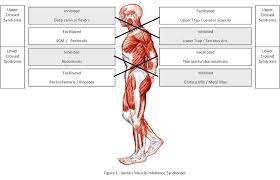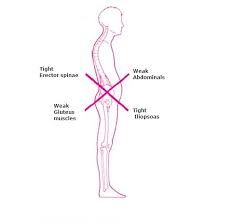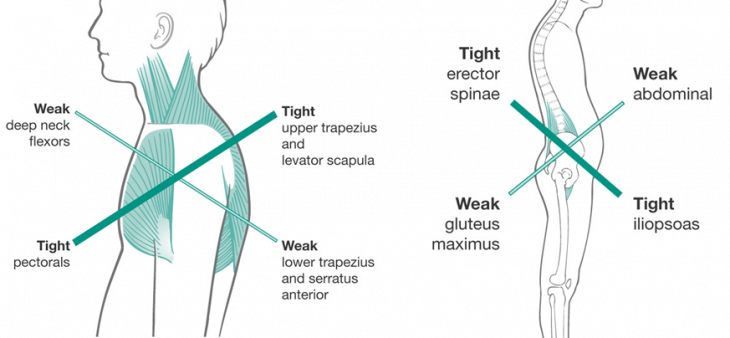If you’re experiencing pain in your neck and shoulders, it’s possible that you’re suffering from the upper cross syndrome. This condition is caused by bad posture and can lead to a wide variety of problems if left untreated. In this blog post, we will discuss the symptoms of the upper cross syndrome, as well as how to treat it. We will also talk about the lower cross syndrome, which is a related condition that can also cause pain in the neck and shoulders. Let’s get started!
Contents
What Is Upper Cross Syndrome?

The upper cross syndrome is a common postural deformity caused by tightness and weakness of certain muscles in the upper body. The condition occurs when the neck and shoulder muscles become too tight, resulting in an abnormally hunched posture, while the chest and hip flexors become weak or overstretched. This causes the head to move forward, putting an excessive strain on the neck and shoulder muscles, leading to pain and discomfort.
What Is Lower Cross Syndrome?

Lower Cross Syndrome (LCS) is a common postural pattern characterized by tightness in the hip flexors and lower back muscles, as well as weakness in the abdominal and gluteal muscles. It can be caused by a variety of different factors, such as poor posture or frequent sitting for long periods of time. Common signs of LCS include rounded shoulders, an exaggerated lumbar curve (swayback), hip flexion, and a protruding abdomen.
The muscles involved in lower cross syndrome are typically the iliopsoas, rectus femoris, erector spinal muscles (particularly the longissimus thoracic), gluteal muscles, and abdominals. When these muscles are affected, they can cause the body to be misaligned and lead to chronic pain or injury.
What Are the Symptoms of Upper Cross Syndrome?
When someone has Upper and Lower Cross Syndrome, they may experience discomfort or pain in their neck, shoulders, back, or hips. Other common symptoms include:
- Tight chest muscles
- Decreased range of motion in the shoulder, neck, and thoracic spine
- Lower back pain
- Weak abdominal muscles
- Stiff hips
- Poor posture and balance
What Are the Causes?
There are various causes that can lead to the development of Upper and Lower Cross Syndrome. They are as follows:
Poor posture and muscle imbalances
When muscles become tight or lengthened due to poor posture, it can lead to Upper and Lower Cross Syndrome.
Lack of physical activity
People who do not engage in regular physical activity are more likely to develop the syndrome.
Repetitive stress injuries
These injuries occur when a person is exposed to the same type of movement or activity daily.
Poor ergonomic design
When your workplace setup is not designed properly, it can lead to poor posture and muscle imbalances.
Genetic predisposition
Certain genetic factors may also play a role in developing Upper and Lower Cross Syndrome.
What Type Of Physical Therapy Is Used In this Condition?
There is various physical therapy. They are:
Core Strengthening
This type of physical therapy focuses on strengthening the core muscles, which are located in the abdominal and trunk area. This helps improve posture and balance, as well as reduce discomfort from Upper and Lower Cross Syndrome.
Stretching Exercises
Targeting tight muscle groups can help alleviate pain associated with Upper and Lower Cross Syndrome while also improving flexibility.
Manual Therapy
This can include joint mobilization, massage, and soft tissue manipulation to help reduce tightness in the muscles associated with Upper and Lower Cross Syndrome.
Postural Education
Learning how to correctly sit, stand, or move can help improve posture as well as reduce discomfort from Upper and Lower Cross Syndrome.
Ergonomic Training
Learning how to adjust your workspaces, such as a desk or chair, can also help reduce discomfort from Upper and Lower Cross Syndrome.
It is important to consult with a physical therapist before beginning any physical therapy program for Upper and Lower Cross Syndrome. A physical therapist can work with you to create a personalized physical therapy program that is tailored to your individual needs and goals. Your physical therapist can also provide guidance on lifestyle modifications that may help reduce your symptoms of Upper and Lower Cross Syndrome.
What Are The Treatment Options?
There is various treatment available for the upper and lower cross syndrome. They are as follows:
Physical Therapy
A physical therapist can help to correct the imbalance of muscles through exercises, stretches, and mobilization techniques. This will help improve posture, reduce pain and prevent further injuries.
Massage Therapy
Massage therapy is an effective way to relax tight muscles, increase circulation and reduce inflammation in soft tissues. It can also be used to promote better posture and reduce muscular imbalances.
Strengthening Exercises
A physical therapist can prescribe strengthening exercises to target the muscles that are weak or out of balance. This can help improve posture, reduce pain and prevent further injuries.
Postural Corrections
It is important to correct any postural issues that may be present in order to reduce the strain on the muscles and joints. This can include ergonomic adjustments at work and home, as well as posture exercises.
Lifestyle Changes
Making some lifestyle changes can also help with upper and lower cross syndrome. These may include getting adequate rest, avoiding activities that put strain on the body, and avoiding activities that cause pain.
Ice or Heat Treatment
Applying ice or heat to the affected areas can help to reduce inflammation and pain. Ice should be used for acute injuries, while heat is better for chronic conditions.
Surgery
In some cases, surgery may be required in order to correct structural issues or relieve pressure on nerves or other tissues. This should be reserved as a last resort option and only considered if other treatments are not successful.
If you suspect that you may have the upper and lower cross syndrome, it is important to seek professional medical advice from a doctor or physical therapist. Treatment should be tailored to the individual’s needs, in order to achieve the best possible outcomes. With an appropriate treatment plan in place, the upper and lower cross syndrome can be successfully managed.
These are the treatments available for the upper and lower cross syndrome, but it is important to understand that each individual’s healthcare needs are unique and should be discussed with a physician or physical therapist before beginning any treatment plan.
With the right care and attention, this condition can be managed and pain can be reduced or eliminated. It is also important to understand that this condition may not be completely resolved and may require ongoing management to prevent the recurrence of symptoms. With the correct treatment, individuals with the upper and lower cross syndrome can lead an active and meaningful life.
Preventive Tips
There are various preventive tips:
1. Maintain proper posture while sitting and standing. Slouching puts undue pressure on your back, neck, and shoulders which can lead to upper cross syndrome. Make sure you have the correct ergonomic setup for your workspace, use a lumbar support cushion when possible, make sure to sit with your feet flat on the floor, and avoid slouching.
2. Perform regular stretches and exercises that help strengthen the muscles in your core, back, neck and shoulders. This will help reduce imbalances between the upper and lower body’s muscles which can lead to the upper cross syndrome.
3. Incorporate low-impact cardiovascular exercise into your routine as this will help to improve circulation throughout the body. This will reduce the chances of this syndrome developing.
4. Make sure you are getting enough rest each night so that your muscles can recover from any strenuous activities. Rest helps with muscle regeneration and healing, which is essential in preventing this condition.
5. Increase your water intake to help your body flush out toxins and reduce fatigue, which can lead to the development of this syndrome.
6. Make sure you are eating a balanced diet that includes plenty of fruits, vegetables, lean proteins, and healthy fats. Eating healthy will ensure that your muscles have the energy they need to stay strong and maintain good posture.
By following these preventive tips, you can help reduce your risk of developing this syndrome. Proper exercises, stretches, and diet are all key factors in preventing this condition from developing. If you do begin to experience pain or discomfort, speak with your doctor as soon as possible to find the best possible treatment plan for you.
They can be prevented if the right steps are taken. Don’t wait until it’s too late to start taking care of your body, make sure to stay proactive in taking preventive measures. Your health and well-being depend on it.
Thank you for taking the time to learn more about this condition. Remember, if you ever have any questions or concerns, do not hesitate to reach out to your doctor for answers.
Conclusion
It may be concluded that upper and lower cross syndrome is a debilitating, yet treatable condition. With the proper knowledge and techniques, individuals with the upper or lower cross syndrome can manage their symptoms and improve their physical health. By understanding the causes of the upper and lower cross syndrome, maintaining an active lifestyle, engaging in corrective exercises, and seeking professional help when necessary, those suffering from either of these syndromes can find relief and improve their quality of life. Remember, prevention is the best cure, so start early with regular stretching and strengthening exercises to maintain good posture and muscular balance. With the right tools, the upper and lower cross syndrome does not have to rule your day-to-day activities!
Physical Therapy help patients recover from pain. If you’re experiencing Back pain, Shoulder pain, Knee pain, Neck pain, Elbow pain, Hip pain, or Arthritis pain, a physical therapist at MantraCare can help: Book a physiotherapy session.


